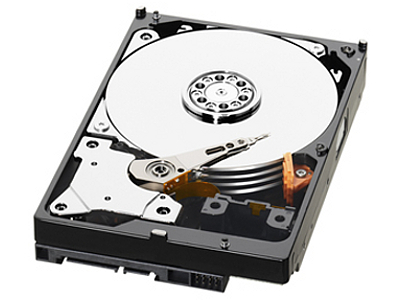Asus Software Unlocks HDDs With Over 2.2 TB
This software for Asus motherboards creates a virtual drive on a 3 TB HDD that can be used in Windows XP, Vista, and 7.

Friday Asus announced Disk Unlocker, a software solution that allows legacy systems to access hard drives larger than 2048GB. The drawback is that the software only works with Asus motherboards and doesn't create a bootable partition based on the 3 TB-ready GUID Partition Table (GPT). Instead, it creates a virtual drive that can be accessed within Windows XP 64-bit, Vista, and 7.
"This is the first software solution to overcome current operating system limitations that prevent a hard disk drive from utilizing more than 2048 GB (also known as 2.2TB)," the company said. "With just a few clicks, Disk Unlocker taps into hidden storage space beyond the nominal 2048 GB range, helping you use large hard drives to their maximum potential."
A hard drive storage capacity greater than 2.2 TB is already supported by the GPT which in turn is natively supported by Windows 7 and Vista. The only real obstacle for Windows 7 and Vista machines is the motherboard's BIOS which wasn't written to handle anything above the 2.2 TB limit. To boot from a GPT partitioned drive, the motherboard needs to be Extensive Firmware Interface (EFI)-capable which supports capacities over 2.2 TB.
Therefore without an additional Host Bus Adapter card (as used with WD's 3 TB HDD) or an EFI motherboard, users are required to install a 3 TB HDD as a secondary disk and allow the OS to create a GPT partition to use its full capacity. The Asus software seemingly steps in to correctly identify the drive for the OS.
According to the manual (pdf), drives with a capacity larger than 2.2 TB will appear in the software's drop-down list-- those smaller than 2.2 TB or already using the GPT format will not appear. The user then hits "Create" to generate a new virtual drive that will take control of the entire capacity. The new space will thus appear in the Virtual Drive field and require GPT partitioning for actual data usage.
For those still using XP, an additional chart shows that Windows XP 64-bit can partition the entire 3 TB drive while 32-bit users can only partition 2.2 TB of capacity. Windows XP users are required to download the Microsoft Native IDE driver before using Disk Unlocker.
The Asus-exclusive Disk Unlocker software is free to download and use, and covers thirty-five chipsets including twenty from Intel, twelve from AMD, and three from Nvidia.
Get Tom's Hardware's best news and in-depth reviews, straight to your inbox.

Kevin Parrish has over a decade of experience as a writer, editor, and product tester. His work focused on computer hardware, networking equipment, smartphones, tablets, gaming consoles, and other internet-connected devices. His work has appeared in Tom's Hardware, Tom's Guide, Maximum PC, Digital Trends, Android Authority, How-To Geek, Lifewire, and others.
-
abswindows7 Another good reason to choose Asus : ASUS Inspiring Innovation • Persistent PerfectionReply
I -
tpi2007 I don't know about you guys, but I find either the descritption given here a bit confusing, or it's really the procedure that is a bit confusing.Reply
From what I understood from the PDF, it means that you can do the normal, which is buy and install a 3TB HDD, format it using the MBR to 2.2TB, and then use this program to create and additional Virtual Drive with the rest of the space.
Now I wonder, why won't this work with other brands of Motherboards ? I guess it does, but Asus did something to prevent that LOL.
-
waffle911 dgingeriWhy can't they just start using UEFI?? Are they really that lazy?Yes. Apple is the only company that cares about using it right now, so until 3 TB HDDs become a must-have for other system builders, mobo companies won't see much of a reason to make it commonplace for consumer boards (enthusiast-class boards included). Once 3TB HDDs becomes more of a consumer-desired feature, then we'll start seeing more enthusiast boards that address this issue.Reply
But hey, aside from that, BIOS has been pretty good to us so far, right?
Why change a good thing?
Right? -
rwpritchett Am I understanding this correctly?Reply
The 2.2TB barrier only applies to partitions with MBR.
Windows Vista and 7 can use >2.2TB partitions as long as it is formatted GPT (storage drive, can't boot from it).
So, how many people out there want to use a >2.2TB partition for the OS? Why not create a MBR partition for the OS that is a reasonable size and partition the rest as appropriate for storage? Having a single ginormous partition with OS, apps, data, etc. seems a bit fool hardy.
BTW, I also would like manufacturers to make the switch to EFI. -
bison88 I've tried researching the whole EFI supported mobos for the past few months and it doesn't seem that important that motherboard manufacturers add it to the detail list. I have a feeling the move from 3TB and beyond is going to be a huge cluster **** if nobody is going to release this info.Reply
Luckily I'm with Asus so I could just download this tool in the future, but seriously a list needs to be compiled or something because I wont buy a new motherboard without knowing this when it's time to upgrade. -
Darkv1 It's nice to see that this utility is being distributed for free as opposed to being a paid piece of software...Reply -
spectrewind Choosing to rely on ASUS exclusively for something like this is a terrible idea. In the event of a software problem, making this virtual disk inaccessible, how do you get your data back when Asus support proves unable to do it (or chooses not to)?Reply
Should the vendor make a business decision to move away from it (leaving no support for it anywhere), where does this leave the purchaser.
This needs redundancy.